

Melted Wood Sculptures by Bonsoir Paris. Liquid marble: now you can walk on water. Pipe cleaner artist. Honeycomb sculptures co-created with bees. A decaying bread world: art series by Johanna Martensson. Incredible Anatomical Sculptures by Maskull Lasserre. Behold the breathtaking sculptural work of Canadian artist Maskull Lasserre who deftly extracts the most delicate anatomical forms of humans and animals from common objects.

Lasserre was born 1978 in Calgary, Alberta and has lived in South Africa and Ottawa and now works and lives in Montreal. Via his website: Lasserre’s drawings and sculptures explore the unexpected potential of the everyday and its associated structures of authority, class, and value. Elements of nostalgia, allegory, humor, and the macabre are incorporated into works that induce strangeness in the familiar, and provoke uncertainty in the expected. His snake skeleton axe entitled Secret Carpentry is one of the most superb sculptural objects I’ve ever seen and don’t miss his work with computer software manuals, newspapers, coat hangers, and tree branches.
Hyper-realistic Sculptures are Made Entirely of Wood by Tom Eckert. Artist and Professor Tom Eckert uses traditional processes to carve these hyper-realistic sculptures of everyday objects entirely made of wood.
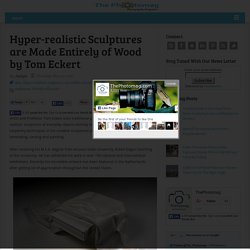
He uses plenty of carpentry techniques in his creative sculptured pieces, such as constructing, bending, laminating, carving and painting. After receiving his M.F.A. degree from Arizona State University, Eckert began teaching at the university. He has exhibited his work in over 150 national and international exhibitions. Recently his incredible artwork has been featured in the Netherlands after getting lot of appreciation throughout the United States. For more details about his work please visit Eckert’s website www.tomeckertart.com. Yuki Matsueda. ‘While most designers are busying adding more and more elements into their artworks, Japan-based Yuki Matsueda has, however, managed to let some elements escape from his art pieces.
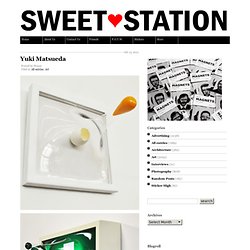
The result seems quite amazing… A vivid 3D image is successfully created and all the elements are believed to be more shocking than those stay still on paper.’ Moss Graffiti. Human again: Bodypaint slowly eroded by milk. Landfill Harmonic: Music made from trash. Heather Dewey-Hagborg Uses DNA To Reconstruct Your Identity for Art. When was the last time you may have left a strand of your hair lying around on a subway seat or on a coffeeshop chair?

You probably don’t think about this too much. But this laissez-faire attitude towards leaving around traces of ourselves (or at least our DNA) might be changing in the very near future. Thanks to a host of new technologies, a single strand of our hair (or a spot of blood, saliva, urine, etc) can tell people a whole lot more about us than we might think. Beyond matching criminals to crime scenes and running paternity tests, DNA can be used for all sorts of identification processes. The ever decreasing cost of genetic technologies, from DNA extraction to transgenic mouse creation, have enabled artists to start playing around with this technology — and the results are eye-opening.
Recently, two different artists made use of a single human hair to very different ends. Image: Dan Phiffer Image: Thomas Dexter The resulting face Tell me about the other hairs you collected. Incredible portraits created from strangers' DNA. Food Lovers: amazing edible art by Studio 23 in Rome. Morgan Herrin. Madeline von Foerster by okmarzo April 21, 2014.

Anamorphic Sculptures. London-based artist Jonty Hurwitz creates ‘Anamorphic Sculptures’ which only reveal themselves once facing a reflective cylinder.
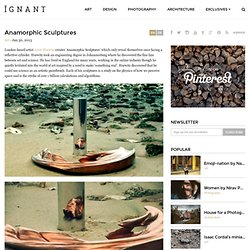
Hurwitz took an engineering degree in Johannesburg where he discovered the fine line between art and science. He has lived in England for many years, working in the online industry though he quietly levitated into the world of art inspired by a need to make ‘something real’. Hurwitz discovered that he could use science as an artistic paintbrush. A 700 Euro pair of shark skin gloves you can’t take off. Mini faux human skin furniture. Wolfgang Stiller's matchstick men. Classical art sculptures dissected as flesh.
Creepy vampire and zombie Reborn dolls. Sculptures made of Staedtler pencils. Animals made from wood shavings. If you think you’re good at working with wood, prepare for complete artist envy.
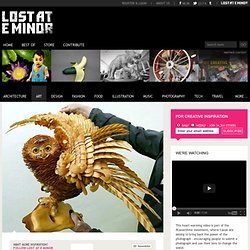
These amazing animal designs have been meticulously crafted from wood shavings by Sergei Bobkov, from Siberia. The fur, feathers and whiskers of the animals are all true to form and from what we can tell from the Russian translations, have taken many, many hours to carve and shape – not to mention the time spent removing splinters! That’s what we call dedication. New World Transparencies by Iori Tomita. Japanese artist Iori Tomita combines art and science in his series, New World Transparencies.
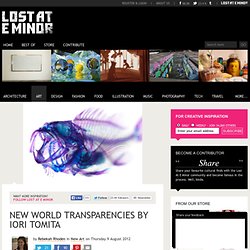
Tomita soaks his specimens in a mixture of blue stain, ethyl alcohol, and glacial acetic acid before using the enzyme trypsin to breakdown muscles. He dyes the organisms with red dye and potassium hydroxide and then preserves them in glycerine. Gino De Dominicis’ Calamita Cosmica. Gino de Dominicis’ Calamita Cosmica is a 28 meter long gigantic skeleton sculpture in the Palazzo Reale in Milan, Italy.

Japanese kids make happy art from dark debris. When the kids from one of Ishinomaki’s elementary schools, Watanona, were handed disaster debris from the 2011 Tohoku earthquake and tsunami to create art from, they sculpted playful inventions such as a cat faced telephone, a cone-hat gnome and a pear-shaped salaryman with pine fruit hair.
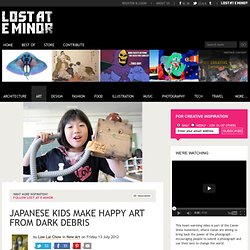
It shows how even the darkest material can elicit happiness in the right hands. And in this case, they are tiny hands that hold a huge amount of potential. Fruit camera, veggie scooter, and egg plant by Dan Cretu. It’s not just us humans who get an identity crisis these days, food — with a little help from humans — get their fair share of the malady too. Glamourous knitted hair by Louise Walker. Violent tape installations by Monica Grzymala. Cooking strainers used to project portrait shadow art. Cooking strainers are usually used to strain liquids off food products.
It’s usually something we don’t take much notice of. Artist Isaac Cordal adds another purpose to strainers through his urban installation called Cement Bleak. Fruit and veggie skulls by Dimitri Tsykalov. Life-size cardboard sculptures by Chris Gilmour. Born in the UK and now residing in Italy, Chris Gilmour creates amazing life-size sculptures all out of objects found in our workspace or at home, such as cardboard and glue.
As kids, our imaginations was endless when we saw cardboard boxes. Book Igloo by Colombian artist Miler Lagos. Sea urchin sculptures made from pencils by Jennifer Maestre. Dinner Etiquette series by Sonia Rentsh. Human skulls made into elaborate art by Philippe Pasqua. French artist Philippe Pasqua has taken human skulls and adorned them with materials including silver and gold leaf, butterflies and tattoos. Eerie and disturbing to some, strangely beautiful to others.